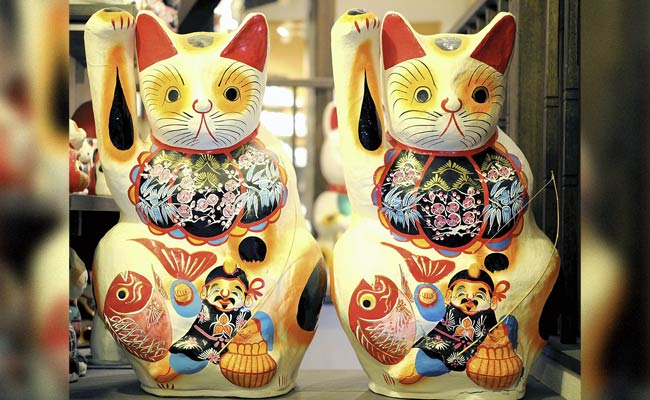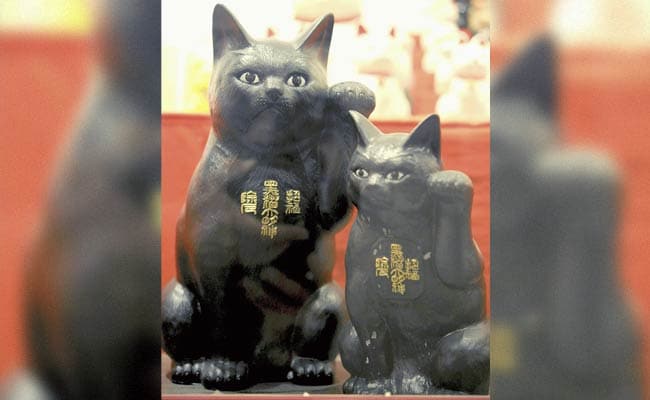
Manekineko lucky cats in various forms, sizes and colors are on display at the Manekineko Museum in Seto, Japan. Photo Credit: The Washington Post/The Japan News/Yomiuri
TOKYO:
Manekineko, lucky cat figures that invite various blessings with their beckoning paws, enjoy great popularity as good-luck charms. The figures vary in origin, size, design and type.
These cats have round heads, large eyes and often hold a koban - a thin oblong gold coin in circulation from the late 16th century to around the end of the Edo period (1603-1867) - in one of their paws.
"The type manufactured in Tokoname [in Aichi Prefecture] caught on after the end of World War II," said Kanji Bando, a collector of and expert on manekineko who is also a photographer specializing in cats. "It's relatively new, considering the history of manekineko dating back to the late Edo period."
Bando has collected about 5,000 manekineko figures over a period of 30 years with his wife, Chihiro Arakawa. Most of their collection is on display at the Manekineko Museum in Seto.
Lucky cats are made from various materials and manufacturing methods, according to Bando.
Those made of clay are manufactured in various places around the nation and have different regional characteristics.
Clay lucky cats in the style of the Shibahara doll, a specialty of Chiba Prefecture, have adorable, relaxing facial expressions. Papier-mache lucky cats manufactured in Takasaki, Gunma Prefecture, have faces that make them look like folk-art toys.

Manufacture of porcelain lucky cats began in the Meiji era (1868-1912). The Seto area in Aichi Prefecture pioneered the manufacturing of such manekineko. The area's products are somewhat more slender than other lucky cats, perhaps because their style was influenced by the fox dolls made in the Fushimi style, a traditional folkcraft manufactured in Kyoto Prefecture.
Porcelain lucky cats made of Kutani ware manufactured in Ishikawa Prefecture were meant for export. "These cats are painted in various colors to meet the tastes of Western people," Bando said. "They have an exotic Asian touch."
Tokoname-style lucky cats are the most popular type today. These cats, however, did not hold the signature gold coin at first. A bell was originally attached to the cats' collars and was later replaced by the coin. Later, the coin came to be held by a paw. The coin at first bore kanji characters reading "senryo." "Senryo" is equal to 1,000 koban gold coins, but also means a great amount of money or something very valuable. The characters were sometimes "manryo" (10,000 koban coins). They were later lavishly boosted to "senmanryo" (10 million koban coins) and even "okumanryo" (billion koban coins).
"Lucky cats that seemed to bring about luck with money became popular in the nation's high-economic growth period," Bando said.
Some lucky cats have either the right paw or the left paw raised, while some have both paws raised. It is said that lucky cats with a raised right paw will attract money and ones with a raised left paw will bring people to shops or businesses. Having both paws raised is meant to invite both money and people, while some people shun lucky cats with both paws raised as it could be taken to mean that the cat has raised both paws in despair. It is said that a lucky cat with a paw raised higher than the ear will bring greater good luck.
The bodies of lucky cats are usually white, but come in other colors, too.
Black lucky cats, for example, are meant to expel evil. Lucky cats in the form of Kuroneko Daimyojin (great black cat deity) in the Matsushiro district in Nagano look very similar to real cats. Gold or yellow cats are meant to bring good luck with money and red lucky cats are meant to prevent diseases.

Recently, lucky cats often have unconventional features. Some hold items other than a gold coin, such as a daruma doll (modeled after Bodhidharma) for good luck. To raise their appeal to people in other countries, lucky cats sometimes hold a surfboard or a bag that bears a dollar sign. Some new ones have a modern feel, decorated with glittering ornaments.
Bando said he feels the blessings that Japanese seek with lucky cats have changed from luck with money to luck with relationships, and recently to luck with being able to relax.
"I look forward to seeing new types of manekineko in the future," Bando said.
These cats have round heads, large eyes and often hold a koban - a thin oblong gold coin in circulation from the late 16th century to around the end of the Edo period (1603-1867) - in one of their paws.
"The type manufactured in Tokoname [in Aichi Prefecture] caught on after the end of World War II," said Kanji Bando, a collector of and expert on manekineko who is also a photographer specializing in cats. "It's relatively new, considering the history of manekineko dating back to the late Edo period."
Bando has collected about 5,000 manekineko figures over a period of 30 years with his wife, Chihiro Arakawa. Most of their collection is on display at the Manekineko Museum in Seto.
Lucky cats are made from various materials and manufacturing methods, according to Bando.
Those made of clay are manufactured in various places around the nation and have different regional characteristics.
Clay lucky cats in the style of the Shibahara doll, a specialty of Chiba Prefecture, have adorable, relaxing facial expressions. Papier-mache lucky cats manufactured in Takasaki, Gunma Prefecture, have faces that make them look like folk-art toys.

Manekineko in the papier mache style manufactured in Takasaki have faces that make them look like folk-art toys.
Photo Credit: The Japan News/Yomiuri
Manufacture of porcelain lucky cats began in the Meiji era (1868-1912). The Seto area in Aichi Prefecture pioneered the manufacturing of such manekineko. The area's products are somewhat more slender than other lucky cats, perhaps because their style was influenced by the fox dolls made in the Fushimi style, a traditional folkcraft manufactured in Kyoto Prefecture.
Porcelain lucky cats made of Kutani ware manufactured in Ishikawa Prefecture were meant for export. "These cats are painted in various colors to meet the tastes of Western people," Bando said. "They have an exotic Asian touch."
Tokoname-style lucky cats are the most popular type today. These cats, however, did not hold the signature gold coin at first. A bell was originally attached to the cats' collars and was later replaced by the coin. Later, the coin came to be held by a paw. The coin at first bore kanji characters reading "senryo." "Senryo" is equal to 1,000 koban gold coins, but also means a great amount of money or something very valuable. The characters were sometimes "manryo" (10,000 koban coins). They were later lavishly boosted to "senmanryo" (10 million koban coins) and even "okumanryo" (billion koban coins).
"Lucky cats that seemed to bring about luck with money became popular in the nation's high-economic growth period," Bando said.
Some lucky cats have either the right paw or the left paw raised, while some have both paws raised. It is said that lucky cats with a raised right paw will attract money and ones with a raised left paw will bring people to shops or businesses. Having both paws raised is meant to invite both money and people, while some people shun lucky cats with both paws raised as it could be taken to mean that the cat has raised both paws in despair. It is said that a lucky cat with a paw raised higher than the ear will bring greater good luck.
The bodies of lucky cats are usually white, but come in other colors, too.
Black lucky cats, for example, are meant to expel evil. Lucky cats in the form of Kuroneko Daimyojin (great black cat deity) in the Matsushiro district in Nagano look very similar to real cats. Gold or yellow cats are meant to bring good luck with money and red lucky cats are meant to prevent diseases.

These Kuroneko Daimyojin black manekineko in the Matsushiro district in Nagano are said to expel evil; it is said that lucky cats with a raised right paw will attract money and ones with a raised left paw will bring people to shops or businesses.
Photo Credit: The Japan News/Yomiuri
Recently, lucky cats often have unconventional features. Some hold items other than a gold coin, such as a daruma doll (modeled after Bodhidharma) for good luck. To raise their appeal to people in other countries, lucky cats sometimes hold a surfboard or a bag that bears a dollar sign. Some new ones have a modern feel, decorated with glittering ornaments.
Bando said he feels the blessings that Japanese seek with lucky cats have changed from luck with money to luck with relationships, and recently to luck with being able to relax.
"I look forward to seeing new types of manekineko in the future," Bando said.
Track Latest News Live on NDTV.com and get news updates from India and around the world

